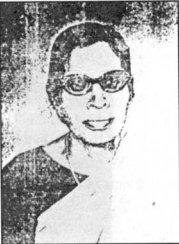T. A. Sarasvati Amma facts for kids
Quick facts for kids
T. A. Sarasvati Amma
|
|
|---|---|

T. A. Sarasvati Amma obituary photo
|
|
| Born | 26 December 1918 |
| Died | 15 August 2000 |
| Occupation | Mathematician |
T. A. Sarasvati Amma (born Tekkath Amayankottukurussi Kalathil Sarasvati) was a brilliant scholar from Kerala, India. She was born on December 26, 1918, and passed away on August 15, 2000. Sarasvati Amma made important contributions to the history of mathematics and the study of Sanskrit. She is especially known for her book, Geometry of Ancient and Medieval India.
Contents
Her Life and Education
Sarasvati Amma was born in a place called Cherpulassery in the Palakkad district of Kerala. She was the second daughter of Kuttimalu Amma and Marath Achutha Menon.
She loved learning and studied a lot. She earned her first degree in mathematics and physics from Madras University. Later, she got a master's degree in Sanskrit from Benares Hindu University. For her research, she worked with Dr. V. Raghavan, who was a famous Sanskrit scholar.
Teaching and Leadership
Sarasvati Amma dedicated many years to teaching. She taught at several colleges, including Sree Kerala Varma College in Thrissur and Maharaja's College in Ernakulam. She also taught at Women's College in Ranchi.
From 1973 to 1980, she became the principal of Shree Shree Lakshmi Narain Trust Mahila Mahavidyalaya in Dhanbad, Jharkhand. This means she was in charge of the whole college! After she retired, she returned to her hometown of Ottappalam where she spent her last years.
Sarasvati Amma had a younger sister named T. A. Rajalakshmi. Rajalakshmi was also a talented writer, known for her stories and novels in the Malayalam language. Sadly, she passed away in 1965.
Her Work in Mathematics
Sarasvati Amma's most important work is her book, Geometry in Ancient and Medieval India. This book explores how geometry was understood and used in India a long, long time ago.
Exploring Ancient Indian Geometry
Her book looks at many old Indian texts, from the very old Vedic literature to writings from the 17th century. She studied the Sulba Sutras, which are ancient Indian texts about building altars and have a lot of geometry in them. She also looked at mathematical parts of Jaina religious books and Hindu scientific works.
Sarasvati Amma's book also highlights the contributions of many famous Indian mathematicians and astronomers. These include Aryabhata I & II, Sripati, Bhaskara I & II, Sangamagrama Madhava, Paramesvara, Nilakantha, and many others. She also studied the works of mathematicians like Mahavira, Sridhara, and Narayana Pandita, as well as the Bakshali Manuscript.
Changing How We See Indian Mathematics
Before Sarasvati Amma's book, some people thought that Indian mathematicians were mostly good at algebra and calculations, but not so much at geometry or proving things. Her book showed that this wasn't true! She proved that there was a strong tradition in India of using geometric methods to understand and show algebraic results.
Her book is considered a very important work for anyone studying the history of mathematics in India. The Kerala Mathematical Association even started a special lecture series in her honor in 2002, called the Prof. T. A. Sarasvati Amma Memorial Lecture.

